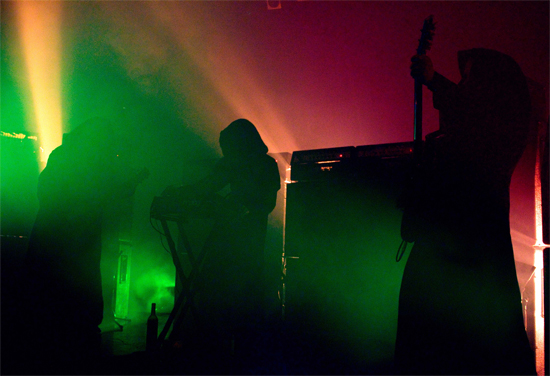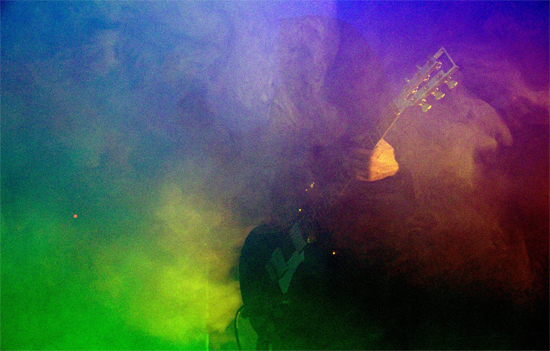Before you read on, we have a favour to ask of you. If you enjoy this feature and are currently OK for money, can you consider sparing us the price of a pint or a couple of cups of fancy coffee. A rise in donations is the only way tQ will survive the current pandemic. Thanks for reading, and best wishes to you and yours.
My first experience of Sunn O))) live was at ATP’s tenth birthday celebrations in 2010. There were a fair few bands I wanted to see, but I was mostly there to waft from stage to stage in a medicated haze. Having launched into my teenage years as a rock fan with delusions of grandeur, I was by this point more or less fully in thrall to the logic of dance music culture: the understanding that the singular hedonic moment (I’m having a good time) is of more value than the more abstractly significant one (I’ve always wanted to see this band); that music’s functionality, its role in the pursuit of pleasure, is ultimately more divine than an artist’s expression of their self-ness or the canonic importance of witnessing a great band perform. Seriously, fuck holding in a piss, silencing the cries of protest from your lower back and running sandpaper tongue round parched mouth for the nth time, just because this is so-and-so’s first gig in a decade and you don’t want to miss the encore. This was my view at the time, anyway.
Central to this logic – and by inference to the seductive power of dance music, its rituals and its unwritten rules – is the importance of sonic affect: the un-decoded materiality of sound waves impacting on and moving through your body. And central to that – whether you’re talking about disco, minimal techno, dubstep or whatever else – is bass: those primal frequencies that are felt not heard, resonating through the chest and the bowels, vibrating the soul.
Julian Henriques neatly encapsulates the effects of high-intensity bass-quake in his concept of ‘sonic dominance’: the notion of a sound so loud and overwhelming that its effects tip over into some newly visceral realm. Drawing on Jamaican sound system culture as his example, Henriques identifies the effects of high-volume, bass-heavy sound thus:
"Sonic dominance is hard, extreme and excessive. At the same time the sound is also soft and embracing and it makes for an enveloping, immersive and intense experience. The sound pervades, or even invades the body, like smell. Sonic dominance is both a near over-load of sound and a super saturation of sound. You’re lost inside it, submerged under it. This volume of sound crashes down on you like an ocean wave, you feel the pressure of the weight of the air like diving deep underwater. […] Even more than music heard normally[,] at this level sound allows us to block out rational processes, making the experience imminent, immediate and unmediated."
Those who’ve been to a reggae sound-system dance, or to DMZ at Mass, the Berghain or any other of dance music’s innumerable meccas, will identify with this description instantly. It’s the loss of control, the submission (willing or unwilling) to frequencies that spin out your balance organs and crush the air out of your lungs – an experience at once terrifying and liberating, and one that’s been intrinsically linked with the electronic dance-music culture of the past three decades or more.

Once your nervous system is attuned to the effects of sonic dominance, a lot of non-electronic (for want of a better term) music starts to lose its lustre, at least in a live setting. It’s too often broadcast over inferior (or less ambitious) PAs, relying on excoriating high end and a general sonic indistinctness as its shorthand for heaviness. After all, the focus lies elsewhere, in performance, personality and live-ness. (Obviously there is huge merit in these things too, and there are plenty of exceptions to this broad-brush dichotomy, but you get the gist.)
So, drifting over to see Sunn O))) in the stale confines of Butlins, I was intrigued but not massively excited. I knew roughly what I was letting myself in for, having heard the odd glowing testimonial. But, truthfully, nothing prepares you. The band were performing both The GrimmRobe Demos and Monoliths & Dimensions in their entirety at the festival, and both of these sets had me utterly rapt for the duration. They rank among the most incredible I’ve ever had the pleasure of experiencing.
I wasn’t really aware of it back then, but it’s struck me since how similar the Sunn O))) MO is to that of much of the dance-music world. Not at the level of style, of course, but in philosophy, technique and effect there’s more common ground than you’d think. Perhaps, in some sense, Sunn O))) represent the realisation of a certain set of musical/cultural/physiological objectives commonly associated with dance music, only approached from a radically different angle (maybe this is what Autechre recognised when they booked Sunn O))) for the ATP they curated back in 2003). Perhaps, in a world where stylistic groupings were determined by something more deeply rooted – or at least less cosmetic – than tempo, instrumentation, rhythmic and melodic patterns, we would see Sunn O))) regularly sharing bills with Rhythm & Sound, Shackleton, DJ Stingray, Mala, Spinn & Rashad…
It’s this thought that’s sluicing through my brain as I wait for the band to come on stage at Camden’s Koko, doing my utmost to hold ground in the pre-show scrum for optimum positions. There’s a provisional checklist of comparisons to be made. For one thing, I’m struck by the band’s functionalist streak. The name: cadged from a favoured brand of amplifier, in much the same way that 303, 808, 909 and the rest pop up in the dance-music lexicon generation after generation. And then there’s the near-legendary stage spec – that imposing wall of speaker stacks, the list of favoured frequencies, the exhortation that “MAXIMUM VOLUME YIELDS MAXIMUM RESULTS” – which calls to mind Metalheadz technicians at the Blue Note wandering the room, decibel meters in hand. Of course this insight isn’t unique to dance-music culture, but DJs, producers and even fans operating within it seem more comfortable than most with the idea that the dry can lead to the delicious: that music can in a sense be more a science than an art, but science as a route to breathtaking artistry, the most effective means to a fiercely defined aesthetic end.

Naturally, though, music types with well-calibrated priorities don’t like to be overly reminded of the science; hence why Sunn O)))’s inaugural tour, supporting Orange Goblin – sans smoke, robes and the rest – was reportedly so badly received. And so you get the ritual. Tonight, all the familiar Sunn O))) calling cards are in place. The smoke machine kicks in ten minutes before the performance and doesn’t let up for the duration, fluctuating only occasionally between “sickly mist” and “palpable smog”. When they enter, Greg Anderson, Stephen O’Malley, vocalist Attila Csihar and a fourth member on Moog are, as always, robed to the nines. All movements are executed with a hallowed slowness – from the formalised gestures to mark a chord change through to the occasional swig from the bottles of red wine to hand. For Henriques, sonic dominance occurs in “the cyclical yet unrepeatable place of recurring ritual”: a place which is simultaneously uniquely here and now and somehow timeless. Sunn O)))’s ritualistic construct, like that of the sound-system culture Henriques studies, has evolved organically through a reciprocal process of performance, reception and alteration. It’s a tiny subculture with its own bizarre customs, its own internal logic and its own insanely faithful band of devotees, who return time and again to go through the same consecrated motions.
There’s certainly a sense of the familiar, seeing Sunn O))) perform after a couple of years’ break. In time-honoured tradition, Anderson and O’Malley open proceedings with the most basic unit of the Sunn O))) vocabulary: that monumental, throbbing drone. Eventually, after what seems like an impossible expanse of time, the note shifts down a semitone, then shifts again, coalescing into a riff so glacially slow that its repetition is only registered in some reptilian part of the brain. Round it goes, the Moog entering to thicken the already unbearably focused, penetrative sound, each iteration fractionally more overwhelming than the last. The sensitivity to dynamic, to the minute differences in power registered by the body more than the mind, is astonishing. It is producerly precision (usually facilitated with the help of studio machinery and endless tweaking) executed on the fly. A display of virtuosity, yes, but also a kind of anatomical probing: where are our limits? What’s the tipping point?

About half an hour in, we reach it. By now, bass has filled the theatre, clogging every pore, an immaterial but impossibly imposing presence. At these volumes the oscillations have what feels like a homogenising effect on matter, dissolving the distinctions between air and body, interior and exterior, you and me – we all float in its serous embrace. The audience occasionally raise their hands in silent affirmation: some in clenched fists, as if staunchly resisting the oceanic flow, some in Sunn O)))’s signature claw. More intriguing to me, though, are the ones who hold both hands open in supplication, laying themselves bare to the torrent of sound, as if inviting the unremitting beam of sonic force to strip their bodies away, layer by layer, until all that’s left is a cloud of vibrating atoms. Is this pleasure or pain, an expression of freedom or an act of subservience? One of Henriques’ keenest insights is that the border between tyranny and ecstasy can be porous in the extreme. In the right environment the loss of self-determination can be heady, euphoric: a sublimation into some larger whole that’s both alien and familiar. Perversely, Sunn O)))’s use of the imagery of the diabolical – those cloaks, the smoke, Csihar’s gruesome babel – enhances this effect. Somehow, a shared suffusion of dread diffuses any sense of real dread. What’s left is a collective shiver of pleasure, the tingle of a danger tamed but also of some more immediate, fascinating, inarticulable experience.
Eventually the suffocating crescendo opens out on to something (relatively) lighter; material from Monoliths, with Anderson and O’Malley stepping back to create space for Csihar’s unearthly vocals. The pair behind me take this as a cue to start a shrill conversation (with plenty of repetition as their words are lost in the din, obviously), and the spell is broken for a while. I start to become aware that I’ve been standing very still in a hot room for an hour, clutching a now-lukewarm pint of Red Stripe. Thoughts of the journey home crowd in. My legs hurt a bit. Gradually, though, and with inexorable purpose, the quartet begin to build back up towards their cacophonous, horrific finale. And as that suffocating fundamental tone blisters and burns like some miniature sun, and above it ranks of harmonics hum and shimmer with celestial fervour, seeming to emanate not just from the speakers but from everywhere all at once. I start to detect a loping rhythm to it – the contours of a pulse, stretched out to tectonic proportions, buried deep in the richness. And, slowly, probably imperceptibly to the people around me, I begin to dance.



